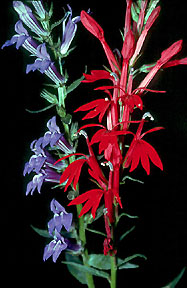
Two fairly common perennial species found in southwest Missouri and southeast Kansas are members of the bellflower family (Campanulaceae) – the Cardinal Flowers, in the genus Lobelia. The genus name honors the Belgium botanist Mathias de L’Obel (1538-1616) who published a book emphasizing that botany and medicine must be based on thorough and exact observations.
Both species produce a milky colored latex that is poisonous, have alternate leaves, and irregular flowers. The primary chemical extracted is lobeline (C22H27NO2). Both can grow to about 60” tall and are found in moist habitats such as stream or creek margins, edges of woods, and ditches.

The blue species is Blue Lobelia; Great Lobelia; or Blue Cardinal Flower, Lobelia siphilitica L. The specific epithet (siphilitica) was derived from one of the medicinal uses of the plant – a cure for syphilis although the plant was tested in England in 1770 and was found to be ineffective. However, in establishing the cure the English scientists used dry material whereas the Amerindians, an indigenous people of the Americas, used fresh root in conjunction with Mayapple and Choke Cherry, and dusted the ulcers formed due to syphilis with New Jersey Tea.
Blue Lobelia has been used as an analgesic, cathartic, diaphoretic, emetic, poultice, and cure for veneral disease. Amerindians used the roots to cure or alleviate dropsy, diarrhea, stomach aches, syphilis, and dysentery. A tea from the leaves was used for colds, fevers, stomach problems, worms, croup, nosebleeds, and gargled for coughs. A poultice was applied to the forehead for pain and hard-to-heal sores. It was also used to induce sweating and urination to cleanse the body.
The red species is Cardinal Flower, Lobelia cardinalis L. The species was first collected from what is now Canada and sent back to France in the 1620s. The specific epithet received its name because the flower color matched the color of the Roman Catholic cardinal’s robes. The Amerindians of the East thought it had magical powers and was used to dispel storms and as a part of various ceremonies. The Cherokee and Iroquois Indians made a tea from the roots to treat epilepsy, syphilis, typhoid, stomach aches, cramps and worms while a tea from the leaves was used to treat croup, colds, nosebleeds, headaches, and fevers.
These two species can cross and produce sterile hybrids with flowers that are magenta in color. **Both can be successfully transplanted to the wildflower garden if they are planted in moist, shaded to partial shaded soil. They can also be easily grown from seed. Start the seeds in flats and then transplant them after they are 10” or more tall.
**Plants should not be dug from the wild. Missouri has strict laws concerning the collection of plants in the state. For more information about plants, contact Dr. Stephen L. Timme. For info about the Sperry Herbarium, go here.
Disclaimer: The medicinal information given here has not undergone scientific scrutiny. The information has been extracted from the literature. Always consult a physician concerning the use of native plants for medicinal purposes.






Comments